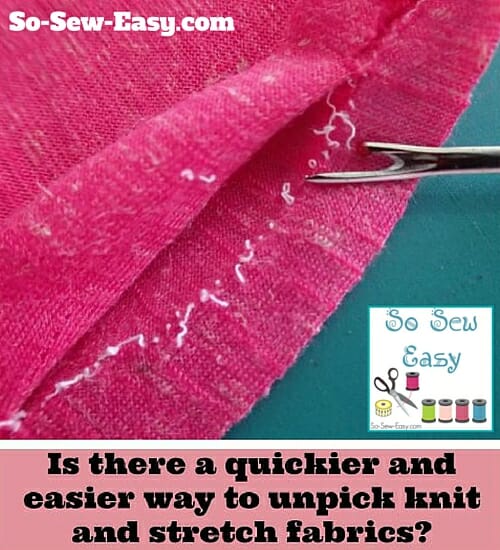
Arghhh. I'm not the biggest fan of seam ripping anyway, but knit fabrics drive me crazy sometimes. Because of the way I sew, with designing my own patterns and projects, I usually end up “un-sewing” a lot of my seams as I make changes to designs as I work. That's all well and good with cotton and other woven fabrics, but when it comes to knits I find that unpicking them is a whole new adventure.
If you recall, for cotton and other wovens, we recently published an article about using an electric seam ripper. If you missed it, you can read all about it in our post entitled: Have you tried an electric seam ripper? More on that later though.
Now back to knits. For a start, we might use different stitches in knits. Not always of course, but perhaps we are using a zig-zag stitch, a special ‘stretch' stitch that looks like a lightning bolt, a triple stretch stitch, or a triple zig-zag. For a start that can mean more stitches per inch than we might use with a woven fabric. The triple zig-zag and the triple stretch stitch are especially difficult to unpick.
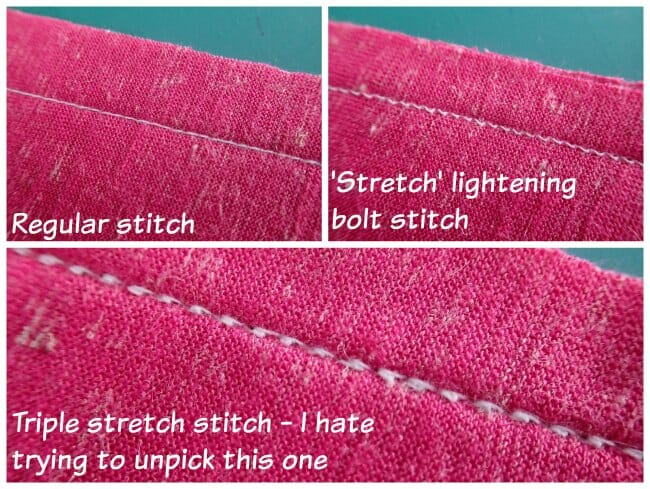

Maybe we are using a serger. If that's the case then the un-sewing isn't necessarily the problem – but if seams have been serged then part of the seam allowance might already have been cut off. Not good when you want to alter that seam. (If you do want to unpick a serged seam, check out the bonus video at the bottom of this article on how to do that easily.)
Whatever stitch you are using, somehow I find that it seems to sink into the knit fabric more, seems more deeply knitted into the fabric. I suppose a knit or stretch fabric might have more loft to it than a quilting cotton for a start so the stitches don't sit on top of the fabric in the same way. For me, it always seems if I make a slip with my seam ripper in a woven, I might poke a hole that I can simply scratch away with my fingernail and move the fibers back into position and you don't even notice it. Poke a knit fabric with the seam ripper and then I make a hole that won't go away, the fibers are damaged or cut and can even ladder. Disaster.
Try to unpick black thread from a black knit fabric – I just can't. Even with my new specs I can't tell the thread from the fabric and end up with holes.
Worst of all, it just takes so darned long. I've tried to speed it along but that just ends up ruining it.
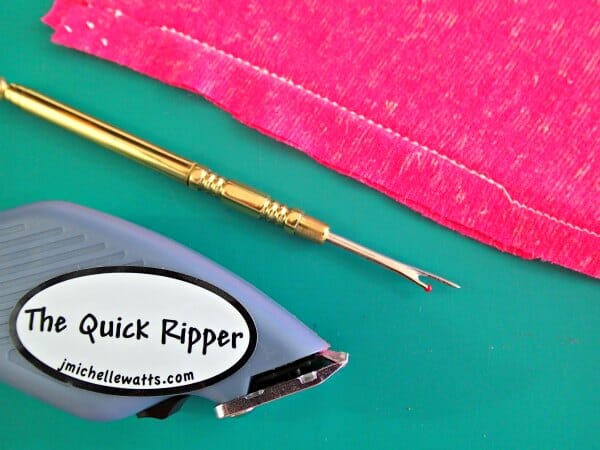

I made up a sample in this pink knit with a regular straight stitch, a lightning bolt stretch stitch, and a triple stretch stitch, just to get some unpicking practice. Arggh, same result pretty much whatever I tried. I even used a white thread to make it easier but I just don't think there is a quick and easy way to unpick knit fabrics.
I tried it with my regular brass seam ripper, which is very sharp and works wonders for me on everything else – I love it so much. I lay it flat along the seam and tried to cut through the threads as I usually do in one quick and easy glide. Not this time – not on knits. It cut through easily and sharply enough, but it ended up ripping holes in the fabric too.
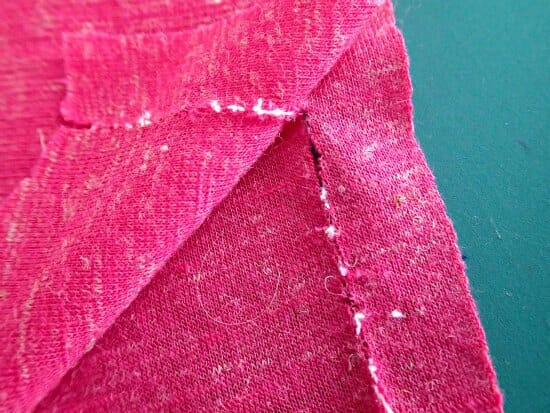

I tried my trusty Quick Ripper electric seam ripper and that was the same. Usually, it can whip through seam ripping in super-quick time and never ever damages the fabric, but try to use it to remove a triple stretch stitch in a knit fabric and it catches the fabric as much as it catches the thread and ends up making holes – big ones! Basically, I ended up cutting the fabric and leaving the stitches where they were. Hopeless. To be fair, that was a pretty tough challenge for it.
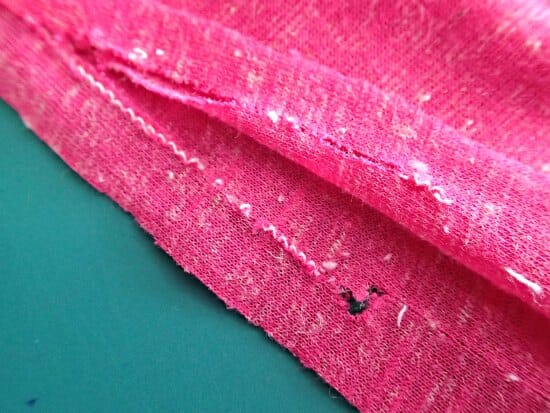

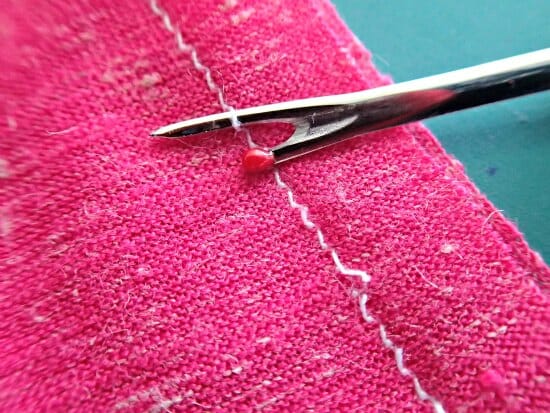

So in the end I had to resort to the slow but sure tried and tested method of unpicking knit fabrics. That means using my brass seam ripper to slide in under individual stitches and cutting the threads every few stitches. That way I can be sure that I'm only catching the thread, not making holes or cutting the fabric. Unless of course I'm unpicking black from black and then I'm doomed again!
It works, but it takes a long time if I have a long length to unpick. No damage to the fabric this way, and of course there are little bits of thread to pull out, and it can be sometimes difficult when the thread is a good match to the fabric because it can be hard to see the thread embedded down into that loftier knit fabric. But if gets the job done eventually and teaches me a lesson to try not to make so many sewing mistakes going forward.
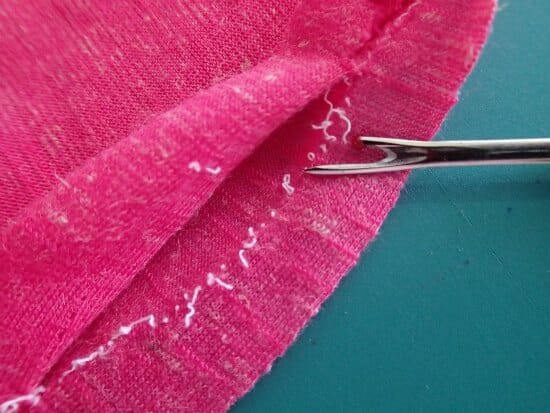

So now I'm looking for your sewing advice. Why is it that unpicking stitches from stretch and knit fabrics is so difficult and do you have any tips for making this quicker while still not damaging the fabric? I'd love to know how you tackle this problem. Please let us know your thoughts in the comments below.








Awesome video on removing served seam!! I said wow 3 times watching that LOL
And this is why I don’t sew knits. lol
Loved the serger stitch trick and all the other very helpful info. Thank you all.
I have a wonderful tool that works great on knits. I”m not sure what it is called but it is shaped like a cuticle cutter with a curved blade, It may be a quilting tool? This tool really allows you to just pick you the thread and clip all in the same move
I never use a seam ripper. I use an exacto blade in the knife holder for all my unpicks. Good lighting and a magnifier glass, along with this sharp blade, accurately works for me. I find I have better control, fewer mistakes (holes), and faster unpicking.
When my daughter asked me two years ago to make her wedding dress….out of stretch lace over stretch lining…..I just about had a coronary! I did a test run for fitting etc on some cheaper fabric but I used my coverstitch machine, single needle. so easy to pull out and make necessary alterations. The entire wedding gown was sown on the coverstitch machine.
Wow! I am impressed since a coverstitch would have been the last thing on my mind to make a wedding dress.
I sewed a big wedding dress completely on a serger lol. I had about 2 weeks to get it done start to finish and was using 3 different patterns – bodice sleeves and skirt, plus a train. It worked great, didn’t have to finish all those seems of that easily fraying fabric. It turned out beautiful and fit pretty great.
Congratulations! what you describe is not easy to accomplish! I am impressed.
Yes, I do the same thing. On a Coverstitch machine, some sergers, and an occasional sewing machine you can do a chain stitch — great for basting! You may need to loosen the tensions a bit.
When all else fails, I’ll gently pull the two fabric pieces apart, exposing the taught seam stitching between them, and snip one seam thread at a time. Excellent lighting and magnification a must!
This is exactly what I do when I’m confronted with a stubborn seam. Thanks for posting this.
Very timely article as I am currently making the “It’s a Wrap” top, and this is my first ever sewing with knits project (I’m fairly experienced with wovens). So, it’s been a lot of learning new skills to cope with this fabric – I probably should have chosen a more stable knit for my first project. I have had to rip out seams twice, and poked some holes in the material in the process. You are right, the lightening bolt stitch is incredibly difficult to unpick. Perhaps I should have made the stitch longer. When I resew, I shall take in the seam a little to avoid the holes. I could just throw this top into the bin labelled sewing disasters; but, it will be the perfect top to go with a skirt I own so I am determined to finish it. Next time, I am going to hand-baste seams first.
[…] Is there an easy way to unpick knit fabrics? […]
I recently purchased a magnifying battery operated light I need to try this for knit stitch ripping.
I currently do my stitch removal in day light as it is better.
I believe I will try basting knits first as slinky knits are miserable to remove stitches.
So true! slinky knits are a pain.
You could try using disappearing thread for the top thread. Once you’re happy with the seam sew it permanently. The disappearing thread dissolves in water. Just soak/lightly wash the garment in warm water. Test first on scrap.
To help with finding black thread on black fabric, or same colour thread and fabric, I find using a white LED lightbulb (in a desk/task lamp) helps immensely. It’s much easier to distinguish thread from fabric, and using magnifying glasses eases eye strain.
Great Tip! Thanks!
Thanks for the serger stitch removal video! Brilliant.
I love my electric seam ripper. One trick I found that works for me is to Clip the end of the bottom piece of fabric to my cutting table with a bulldog clamp. I can hold the top fabric with my hand and just slide the clipper right along the seam.
I haven’t tried it on a knit so will have to see how it works.
I hear you about the black on black! I’m even having trouble with navy and white! I have found working under ab right LED lamp helps a lot with the dark thread but quite the opposite with the white.
A softer light works better for me in that case.
One of the best lighting purchases I’ve made recently is a small table lamp from Daylight that have an LED with a control to change the lighting from bright to soft and also to a warmer light if you choose rather than the bright white.
Hi, Marlette, you LED light sounds like just what I need. What brand is it? Thanks for the tips!
When stitching a new pattern I usually use the largest stitch on my machine, then try the garment on. So much easier to unpick if I need to make any alterations.
My ‘electric seam ripper’ is a Wahl dog clipper from Pets at Home. At £15 it compares favourably to the £40 Wahl charge for their seam ripper. And it works! Haven’t tried it in knits yet but I’ll let you know when I do.
There is also a great stitch removal tool that has rubbery ends that you brush over the ripped out stitches that pull them out. Then you can use a lint roller to pick them up or just use your fingers as the threads are in clumps. It’s my favorite stitch removal tool. Plus, one has two sizes of picks on the ends for smaller and larger stitches or threads…You may need to find them at quilting stores or on-line as I don’t know if Joann’s carries them or not…
I bought mine from Nancy’s Notions
I have a seam ripper with the rubber bits on the ends but find it only works on taut, non stretchy fabric. Selotape works when the rubber one doesnt.
I tend to utter the “U” (unpick) word a lot on my sewing days!
For the short little bits of thread, I went to the newsagent and bought 12 rubber thimbles for $3. I believe they’re used for counting money or separating lots of pieces of paper. The pack had various sizes so I just use the ones to fit my index finger and thumb. This helps to tease out the little threads 🙂
Hope this helps someone. Affordable and useful!
I hate unpicking knits too! Especially some of those finer knits like bamboo so I always baste the seam first using the basting stitch on my machine (I have an actually basting stitch which is very easy to unpick but if you have a coverstitch you can do a chain stitch and it’s super easy to remove as well) – I always baste first then serge or sew the final stitch when I’m happy. The same as I do when working with other fabrics I don’t want to have to unpick like silk.
Love the serger-thread-picking tips. I just received a bag of clothes because the lady gained weight and I lost weight. lol First, everything had to be washed twice because they are a house of smokers. I even washed things that said dry clean because if they ruined, so be it. But in this stash were two jackets, beautifully stitched (one with a Hong Kong finish) but both were too short in the sleeves (as usual). I kept looking at them and thought “vests”. So I removed the sleeves and now have two beautiful vests and they both have collars!! I do have to sew around to finish the armholes but I’m excited. So now I can buy a knit to go under these vests!!!
Thank you. That video to remove the serger seams was very helpful.
For knits I use a surgical seam ripper. I find it pulls less and less likely to create holes if I’m careful. If I’m not careful, I still create holes but much fewer. I can slide ithat ripper between the two fabric and if the blade is sharpe, it will just float through thread.
This is the easiest way of removing serger threads I’ve seen. Thanks a million!
Have you tried the seam rippers that look like a surgical blade inside a comb? Kai?
That will leave lots of short threads which you can pick up with a tape lint remover.
No, I have not, I imagine they are expensive, Thanks for the lint remover tip!
I can’t speak to method but I have found a very helpful tool. My seam ripper has both a light and a magnifier attached! I highly recommend it.
HI, I can’t help with the seam unpicking but with the threads I use painters tape or the lint removal roller,
I use these scissor-like Seam rippers. Works wonder for me. I stretch the seam open and then i can snip through three or four stitches with just one cut.
Ripping knits feels like being punished for something you haven’t done.
LOl!
Just today I discovered that it is easier to unpick the stretch stitch on the back rather than the front. Not sure how easy it is on knits, but on stretch cotton it works a treat. Must be the way the stitch is formed.
Never tried, great tip!
You know what I do? I toss it! Hah! I gave it my best….once…..and said, “FOOOR-GET This!” Now I just buy extra material. Hahahahaaaaaaaaa
I know, I’m not very helpful, now am I???
I guess that’s always an option;) What ever gives you more time to sew!
Thank you so much for teaching me how to rip serger stitches. I knew there how to be a way.
You’re most welcome and happy sewing!
I usually have a lighted desk magnify lamp that I use when picking. It doesn’t make it any quicker but you can pick the threads easier. Once I finish picking I clean up all the loose threads by dabbing the fabric with duck tape. It makes the clean up fast and simple to discard the thread scraps.
I like the duct tape idea! Thanks for sharing. Mayra
Thanks to the previous responders for the great ideas! 🙂
I think slow and steady is the only way to go. I always baste my main knit seams now so I can try it on before committing myself with the serger.
I’ve been basting my knits recently using a standard straight stitch, unless it is an area that needs to stretch, then I’ll use a standard zig zag. Once I’m satisfied with the fit, I go back and “permanently” sew the seams. On black, I use a navy thread inside. Just different enough to see to pick it out (LED lights help), but close enough that no one else will ever notice. Also, when I’m picking stitches, I always go for the bobbin side. Sometimes, I’m lucky enough to get the whole thing to pull out at once!
Thank you! I will try unpicking the bobbin side now!
Two things that might help. When fitting, I use a 5.0 straight stitch. When sewing using my regular machine, I increase the stitch length to 3.5. Having longer stitches seems to help.